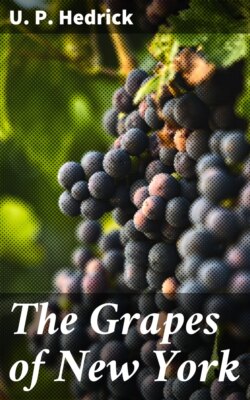Читать книгу The Grapes of New York - U. P. Hedrick - Страница 30
На сайте Литреса книга снята с продажи.
8. VITIS CHAMPINI Planch.[140]
ОглавлениеTable of Contents
1. Planchon, Journ. La Vigne amer., 6:22. 1882 (cited by 4). 2. Munson, Am. Hort. Soc. Rpt., 1885:137. 3. Ib., Am. Pom. Soc. Rpt., 1885:101. 4. Planchon, De Candolle’s Mon. Phan., 5:323, 327, 328. 1887. Champin grape. 5. Munson, Gar. and For., 3:474, 475. 1890. 6. Ib., U. S. D. A. Pom. Bul., 3:11. 1890. 7. Ib., Am. Gard., 12:661. 1891. Champin grape. 8. Ib., Bush. Cat., 1894:20, 22, 25. 9. Bailey, Gray’s Syn. Fl., 1:423. 1897. 10. Beach, N. Y. Sta. An. Rpt., 17:536, 557. 1898. 11. Munson, Tex. Sta. Bul., 56:232, 234, 235, 240, 268. 1900. fig. Adobe Land grape. 12. Viala and Ravaz, Am. Vines, 1903:145.
Vine rather vigorous, climbing (sometimes semi-erect). Shoots thinly pubescent, somewhat angled, generally cylindrical when mature; diaphragms thin; tendrils intermittent, strong, bifid or trifid. Leaves small to rather large, slightly reniform or broadly cordate, usually entire but frequently shortly three-lobed; petiolar sinus wide to medium; dark green, glabrous above with thin cobwebby tomentum below, becoming more or less glabrous when mature. Clusters of small or medium size; peduncle medium in length. Berries large, black, slight if any bloom, very persistent, of sweet flavor and tender pulp. Seeds closely resembling Candicans. Blooms just before Labrusca. Variable in ripening season.
Champini was named and described in 1882 by Planchon. He states that it is probably a hybrid between Vitis candicans and Vitis rupestris and that it is not distinctly defined and of a uniform character, but shows in its variable forms different combinations of the characters of these two species. There seems to be some doubt among other botanists as to the parentage of Champini and it is variously credited to Candicans, Rupestris, Monticola and Berlandieri.
This species is found growing in the limestone hills of southwestern Texas, covering about the same area as Berlandieri. According to Munson it is less common in the bottoms and is not so plentiful as the latter species. Associated with it in different parts of its habitat are the four species mentioned above as possible parents.
Champini is particularly well adapted to hot dry regions and will withstand considerable lime in the soil. The species is susceptible to mildew and black-rot. It can be readily grown from cuttings and grafts well in the vineyard, though the different forms are quite variable in these respects. At one time this species was considered of great promise as a stock for Vinifera for hot, dry regions but as it has proved inferior to Berlandieri in its capacity to withstand limy soils and phylloxera, and as it is not more vigorous, it has been generally dropped. The berries are large and of pure flavor, and as the vine is vigorous, it may prove of value as a source of cultivated varieties for the Southwest but it is of little or no value to the eastern grower.
